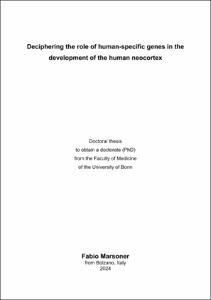Deciphering the role of human-specific genes in the development of the human neocortex

Deciphering the role of human-specific genes in the development of the human neocortex

| dc.contributor.advisor | Koch, Philipp | |
| dc.contributor.author | Marsoner, Fabio | |
| dc.date.accessioned | 2024-01-04T12:22:04Z | |
| dc.date.available | 2024-01-04T12:22:04Z | |
| dc.date.issued | 04.01.2024 | |
| dc.identifier.uri | https://hdl.handle.net/20.500.11811/11222 | |
| dc.description.abstract | The human brain is remarkably complex and has been subject to noteworthy changes throughout evolution. An expansion of progenitor cells is thought to contribute to the complexity and increase in cortical size that is observed in the human cortex as compared to non-human primates. The developmental mechanisms underlying the evolutionary changes are, however, poorly understood. In this doctoral work, gene editing on hiPSCs and hiPSCs-derived organoids was exploited to study the function of ARHGAP11B and TBR2. ARHGAP11B is a human- specific gene expressed in radial glial cells, TBR2 expression is characteristic of intermediate progenitors, conserved during evolution, and highly enriched in humans. In the human neocortex both genes play an important role in establishing the outer subventricular zone (oSVZ). Using CRISPR/Cas9 mediated gene editing, ARHGAP11B and TBR2 hiPSC lines were generated. Following validation, forebrain-type organoid was generated from these KO lines to investigate morphologic and transcriptomic differences between the KO and the isogenic controls. An optimized protocol to generate homogenous organoids up to 2 months of age was developed. Deficiency of ARHGAP11B had an important effect on the expansion of proliferative cells. At early time points the effects could be observed on neuroepithelial (NES) cells while at later stages basal radial glial cells (bRGC) were mainly affected. TBR2 KO derived organoids showed a shift in asymmetrical plane of division of apical radial glial cells (aRG) at early stages. At more mature stages the TBR2 deficiency had an impact on the generation of intermediate progenitors and significantly reduced the amount of layer VI TBR1+ cortical neurons. Taken together, this data indicates that both genes are fundamental for the correct development of the human brain. In their absence the amount of bRG and neurogenesis is impaired. Further studies will focus on their effects in older and or more mature organoids to assess their role in upper layer neurons. Importantly, this doctoral work highlights how transgenic organoids represent a powerful tool to map human-specific gene function in brain development, correlate genetics to functional phenotypes and to complement the long tradition of KO models in developmental biology and neuroscience. | en |
| dc.language.iso | eng | |
| dc.rights | In Copyright | |
| dc.rights.uri | http://rightsstatements.org/vocab/InC/1.0/ | |
| dc.subject.ddc | 570 Biowissenschaften, Biologie | |
| dc.subject.ddc | 610 Medizin, Gesundheit | |
| dc.title | Deciphering the role of human-specific genes in the development of the human neocortex | |
| dc.type | Dissertation oder Habilitation | |
| dc.publisher.name | Universitäts- und Landesbibliothek Bonn | |
| dc.publisher.location | Bonn | |
| dc.rights.accessRights | openAccess | |
| dc.identifier.urn | https://nbn-resolving.org/urn:nbn:de:hbz:5-73516 | |
| ulbbn.pubtype | Erstveröffentlichung | |
| ulbbnediss.affiliation.name | Rheinische Friedrich-Wilhelms-Universität Bonn | |
| ulbbnediss.affiliation.location | Bonn | |
| ulbbnediss.thesis.level | Dissertation | |
| ulbbnediss.dissID | 7351 | |
| ulbbnediss.date.accepted | 29.11.2023 | |
| ulbbnediss.institute | Medizinische Fakultät / Institute : Institut für Rekonstruktive Neurobiologie (IRN) | |
| ulbbnediss.fakultaet | Medizinische Fakultät | |
| dc.contributor.coReferee | Schoch-McGovern, Susanne |
Dateien zu dieser Ressource
Das Dokument erscheint in:
-
E-Dissertationen (1997)




